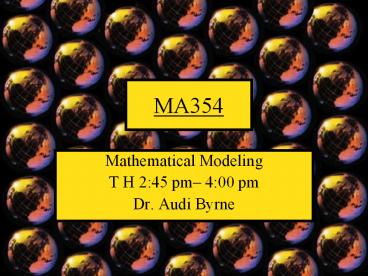MA354 - PowerPoint PPT Presentation
1 / 25
Title:
MA354
Description:
MA354 Mathematical Modeling T H 2:45 pm 4:00 pm Dr. Audi Byrne Your Instructor Instructor: Dr. Audi Byrne Dr. Audi Byrne PhD in mathematics from the University of ... – PowerPoint PPT presentation
Number of Views:142
Avg rating:3.0/5.0
Title: MA354
1
MA354
- Mathematical Modeling
- T H 245 pm 400 pm
- Dr. Audi Byrne
2
Your Instructor
- Instructor Dr. Audi Byrne
3
Dr. Audi ByrnePhD in mathematics from the
University of Notre Dame
4
Dr. Audi ByrneResearch area in
biomathematics.(Dynamical systems and modeling. )
Cellular automata
Stochastic Processes
Multi-cellular Systems
5
Contacting Your Instructor
- Office ILB 452
- Office Hours 1000am-1100am daily
- And by appointment.
- E-mail abyrne_at_jaguar1.usouthal.edu
6
Course Information
- Course webpage
- www.southalabama.edu
- ?Math and Statistics
- ?Faculty and Staff
- ?Audi Byrne
- ? link to personal homepage
- ? teaching
- ? MA 354
- http//www.southalabama.edu/mathstat/personal_page
s/byrne/MA354.htm
7
Mathematical Modeling
- Model design
- Models are extreme simplifications!
- A model should be designed to address a
particular question for a focused application. - The model should focus on the smallest subset of
attributes to answer the question. - Model validation
- Does the model reproduce relevant behavior? ?
Necessary but not sufficient. - New predictions are empirically confirmed. ?
Better! - Model value
- Better understanding of known phenomena.
- New phenomena predicted that motivates further
expts.
8
Types of Models
- Discrete or Continuous
- Stochastic or Deterministic
- Simple or Sophisticated
- Good or bad (elegant or sloppy)
- Validated or Invalidated
9
Modeling Approaches
- Continuous Approaches (PDEs)
- Discrete Approaches (lattices)
10
Continuous Models
- Good models for HUGE populations (1023), where
average behavior is an appropriate description. - Usually ODEs, PDEs
- Typically describe fields and long-range
effects - Large-scale events
- Diffusion Ficks Law
- Fluids Navier-Stokes Equation
11
Continuous Models
- http//math.uc.edu/srdjan/movie2.gif
- Biological applications
- Cells/Molecules density field.
Rotating Vortices
http//www.eng.vt.edu/fluids/msc/gallery/gall.htm
12
Discrete Models
- E.g., cellular automata.
- Typically describe micro-scale events and
short-range interactions - Local rules define particle behavior
- Space is discrete gt space is a grid.
- Time is discrete gt simulations and timesteps
- Good models when a small number of elements can
have a large, stochastic effect on entire system.
13
Hybrid Models
- Mix of discrete and continuous components
- Very powerful, custom-fit for each application
- Example Modeling Tumor Growth
- Discrete model of the biological cells
- Continuum model for diffusion of nutrients and
oxygen - Yi Jiang and colleagues
14
Stochastic Models
- Accounts for random, probabilistic phenomena by
considering specific possibilities. - In practice, the generation of random numbers is
required. - Different result each time.
15
Deterministic Models
- One result.
- Thus, analytic results possible.
- In a process with a probabilistic component,
represents average result.
16
Stochastic vs Deterministic
- Averaging over possibilities ? deterministic
- Considering specific possibilities ? stochastic
- Example Random Motion of a Particle
- Deterministic The particle position is given by
a field describing the set of likely positions. - Stochastic A particular path if generated.
17
Other Ways that Model Differ
- What are the variables?
- A simple model for tumor growth depends upon
time. - A less simple model for tumor growth depends upon
time and average oxygen levels. - A complex model for tumor growth depends upon
time and oxygen levels that vary over space.
18
Spatially Explicit Models
- Spatial variables (x,y) or (r,?)
- Generally, much more sophisticated.
- Generally, much more complex!
- ODE no spatial variables
- PDE spatial variables
- (most general difference)
19
Other Ways that Model Differ
- What is being described?
- The domain of the function.
- The largest expected diameter of a tumor.
- The diameter of the tumor over time.
- The shape of the tumor over time.
20
Objective 1 Model Analysis and Validity
- The first objective is to study the behavior
of mathematical models of real-world problems
analytically and numerically. The mathematical
conclusions thus drawn are interpreted in terms
of the real-world problem that was modeled,
thereby ascertaining the validity of the model.
21
Objective 2 Model Construction
- The second objective is to model real-world
observations by making appropriate simplifying
assumptions and identifying key factors.
22
Model Construction..
- A model describes a system with variables u, v,
w, by describing the functional relationship
of those variables. - A modeler must determine and accurately
describe their relationship. - Accuracy simplicity and computational
efficiency may trump accuracy.
23
Functional Relationships Among Variables x,y
- No Relationship
- Or effectively no relationship.
- No need to use x in describing y.
- Proportional Relationship
- Or approximately proportional.
- x ky
- Inversely proportional relationship
- xk/y
- More complex relationship
- Non-linearity of relationship often critical
- Exponential
- Sigmoidal
- Arbitrary functions
24
Hookes Law
- An ideal spring.
- F-kx
- x displacement (variable)
- k spring constant (parameter)
- F resulting force vector
25
Other Examples
- Circumference of a circle is proportional to r
- Weight is proportional to mass and the
gravitational constant

